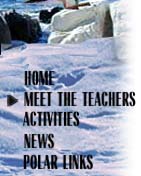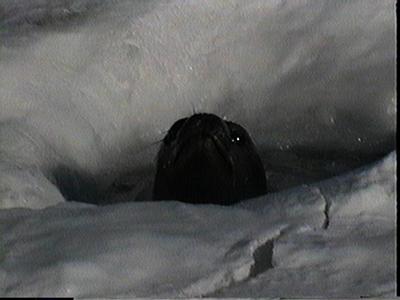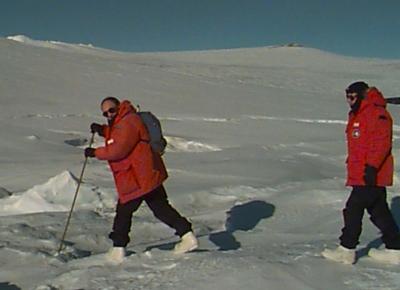
|
|
8 October, 1996
I've decided that my last event of the day would be my journal entry. That
will probably account for some of the gibberish. It's 11:04 P.M. The sun has
gone below the mountains but it still quite light out. It doesn't really get
dark here during this season.
A good portion of the day was spent on the sea ice learning to locate
cracks and crevasses and how to cross them safely. One sure indication that
the ice is cracked is the presence of seals. If seals are on the ice, they
had to squeeze through a body sized opening to get there. Since their bodies
are four to five hundred pounds, there is the potential to fall in where
they crawled out. As we moved along the ice we could hear a seal barking.
Bill followed a crack in the ice until he found a hole where a seal had come
to the surface. As we moved closer to the hole, the seal would disappear
below the surface, when we backed off it would reappear to bark at us.
Even thought the temperature was well below zero, the ice still had weak
spots where an unsuspecting walker could easily fall through. As we moved
off the ice and up onto a small mountain, the six-foot probe I was using to
test the strength of the snow went into a crevasse. We stopped and probed
the crack to find a safe way to cross. By being vigilant and learning how to
recognize signs of weakness in the ice and snow we were able to feel
somewhat secure as we moved along.
When we reached the top of the mountain we found a monument in honor of
Jeffrey Rudd, a scientist who died when he fell through an ice crack. Andy,
a veteran of seven seasons here, told us that three workers recently fell
into a crevasse near the research station. Only one survived and the body of
another has yet to be recovered. Safety is now a top priority on the ice,
there is a training session or safety briefing for almost every aspect of
our work. It does cut down on the amount of work we can accomplish but it
makes me aware of the difficulties and the need for advanced planning when
doing science in this environment.


Contact the TEA in the field at
.
If you cannot connect through your browser, copy the
TEA's e-mail address in the "To:" line of
your favorite e-mail package.
|
